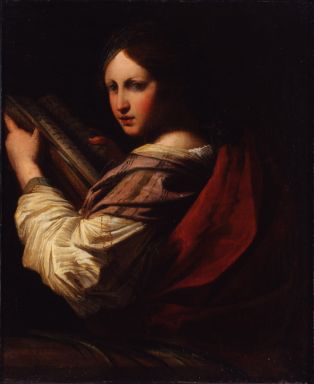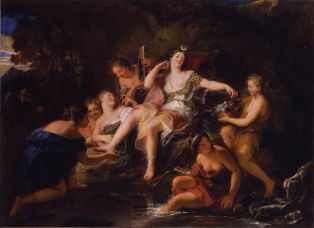- Découvrez les collections
- Notice d'oeuvre



Naples, 1615 ; Rome, 1673
H. 110 cm ; l. 186,5 cm (sans cadre)
M0536_L.I.60
Artiste complet, Rosa est à la fois peintre, dessinateur, graveur, mais aussi poète, musicien et écrivain. Il étudie d’abord à Naples, exerce notamment dans l’atelier de Ribera, avant de devenir élève et ami d’Aniello Falcone, dont il imite la technique réaliste, post-caravagesque. Entre 1635 et 1637, il travaille à Rome pour le cardinal Brancaccio. À Florence vers 1640-1649, c’est le grand duc de Toscane, Ferdinand II de Médicis, qui le prend à son service. Les paysages comportant des saints en méditation ou des anachorètes (moines qui se retirent pour vivre en ermites) sont répandus dès la Renaissance. Au milieu du XVIIe siècle, Salvator Rosa est l’un des grands représentants de ce thème, que l’on peut rapprocher du développement du quiétisme, encourageant la vie contemplative. Au fil de sa production, Rosa s’éloigne de l’idéal de sérénité du paysage classique alors en vogue à Rome, pour se tourner vers une nature plus animée et impressionnante. Sa touche nerveuse et tourmentée, la mélancolie et la dimension fantastique de ses œuvres, donnent naissance à un paysage pré-romantique, que les artistes romantiques du XIXe siècle développeront.
Rosa was a multifaceted artist – a painter, draftsman, and engraver, as well as a poet, musician and writer. He trained in Naples initially, notably in the studio of Ribera, then became a student and friend of Aniello Falcone, whose realist, post-Caravaggio technique he imitated. From 1635 to 1637, he worked in Rome for cardinal Brancaccio. In Florence circa 1640-1649, he was employed by the grand duke of Tuscany, Ferdinando II de’ Medici. Landscapes featuring meditating saints and anchorites (monks who withdraw from society to live as hermits) were popular during the Renaissance. In the mid-17th century, Salvator Rosa was one of the main exponents of this subject matter associated with the rise of Quietism which promoted the contemplative life. Over time, Rosa moved away from the ideal of serenity favoured by the traditional landscape painting fashionable in Rome and turned to a more lively and striking vision of nature. His touch is energetic and tortured, and the melancholic and fantastical elements of his works blazed the trail for a pre-Romantic style of landscape which would be developed by Romantic artists in the 19th century.



 Copyright© WebMuseo 2017 - 2024
Copyright© WebMuseo 2017 - 2024